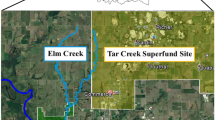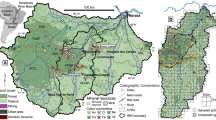Abstract
Inductively coupled plasma (ICP) following aqua regia digestion and X-ray fluorescence (XRF) are both geochemical techniques used to determine ‘total’ concentrations of elements in soil. The aim of this study is to compare these techniques, identify elements for which inconsistencies occur and investigate why they arise. A study area (∼14,000 km2) with a variety of total concentration controls and a large geochemical dataset (n = 7950) was selected. Principal component analysis determined underlying variance in a dataset composed of both geogenic and anthropogenic elements. Where inconsistencies between the techniques were identified, further numerical and spatial analysis was completed. The techniques are more consistent for elements of geogenic sources and lead, whereas other elements of anthropogenic sources show less consistency within rural samples. XRF is affected by sample matrix, while the form of element affects ICP concentrations. Depending on their use in environmental studies, different outcomes would be expected from the techniques employed, suggesting the choice of analytical technique for geochemical analyses may be more critical than realised.




Similar content being viewed by others
References
Albanese S, Breward N (2011) Sources of anthropogenic contaminants in the urban environment. In: Johnson CC, Demetriades A, Locutura J, Ottesen RT (eds) Mapping the chemical environment of urban areas. Wiley-Blackwell, Oxford, pp 116–127
Barrat J, Nesbitt R (1996) Geochemistry of the tertiary volcanism of Northern Ireland. Chem Geol 129:15–38
Barron AR, Wurzburger N, Bellenger JP et al (2008) Molybdenum limitation of asymbiotic nitrogen fixation in tropical forest soils. Nat Geosci 2:42–45. doi:10.1038/ngeo366
Bellenger J-P, Wichard T, Xu Y, Kraepiel AML (2011) Essential metals for nitrogen fixation in a free-living N2-fixing bacterium: chelation, homeostasis and high use efficiency. Environ Microbiol 13:1396–1411
Bettinelli M, Beone G, Spezia S, Baffi C (2000) Determination of heavy metals in soils and sediments by microwave-assisted digestion and inductively coupled plasma optical emission spectrometry analysis. Anal Chim Acta 424:289–296. doi:10.1016/S0003-2670(00)01123-5
Candeias C, Ferreira da Silva E, Salgueiro AR et al (2011) The use of multivariate statistical analysis of geochemical data for assessing the spatial distribution of soil contamination by potentially toxic elements in the Aljustrel mining area (Iberian Pyrite Belt, Portugal). Environ Earth Sci 62:1461–1479. doi:10.1007/s12665-010-0631-2
Carrero JA, Arrizabalaga I, Bustamante J et al (2013) Diagnosing the traffic impact on roadside soils through a multianalytical data analysis of the concentration profiles of traffic-related elements. Sci Total Environ 458–460:427–434. doi:10.1016/j.scitotenv.2013.04.047
Chander K, Hartmann G, Joergensen RG et al (2008) Comparison of methods for measuring heavy metals and total phosphorus in soils contaminated by different sources. Arch Agron Soil Sci 54:413–422. doi:10.1080/03650340801927952
Cobb D (2009) Study on the effectiveness, precision, and reliability of X-ray fluorescence spectrometry and other alternative methods for measuring lead in paint. United States Consumer Product Safety Commission
Cohen DR, Rutherford NF, Morisseau E, Zissimos AM (2012) Geochemical patterns in the soils of Cyprus. Sci Total Environ 420:250–262. doi:10.1016/j.scitotenv.2012.01.036
Díez M, Simón M, Dorronsoro C et al (2007) Background arsenic concentrations in Southeastern Spanish soils. Sci Total Environ 378:5–12
Dzubay TG (ed) (1978) X-ray fluorescence analysis of environmental samples, second pri. Ann Arbor Science, Michigan
ESRI (Environmental Systems Resource Institute) (2009) ArcMap 10.0
Fifield F, Haines P (1995) Environmental analytical chemistry. Blackie Academic and Professional. ISBN 0751400521
Garnham GW, Codd GA, Gadd GM (1993) Uptake of cobalt and cesium by microalgal- and cyanobacterial-clay mixtures. Microbiol Ecol 25:71–82
Gill R (ed) (1997) Modern analytical geochemistry. Addison Wesley Longman. ISBN 0582099447
Green KA, Caven S, Lister TR (2010) Tellus soil geochemistry—quality assessment and map production of ICP data. British Geological Survey Internal Report IR/11/01:142 pp
Hill I, Worden R, Meighan I (2001) Formation of interbasaltic laterite horizons in NE Ireland by early tertiary weathering processes. Proceedings of the Geologists’ Association, 112:pp 339–348
Jarva J, Tarvainen T, Lintinen P, Reinikainen J (2009) Chemical characterization of metal-contaminated soil in two study areas in Finland. Water Air Soil Pollut 198:373–391. doi:10.1007/s11270-008-9852-3
Johnson CC, Ander EL (2008) Urban geochemical mapping studies: how and why we do them. Environ Geochem Health 30:511–530. doi:10.1007/s10653-008-9189-2
Johnson C, Scheib A, Lister T (2010) London earth topsoil chemical results : user guide. British Geological Survey Open Report OR/11/035:16 pp
Jordan C, Higgins A (2009) The AFBI soil classification map of Northern Ireland at 1:50,000 scale. Based on information from Cruickshank, J.G. (ed) 1997, Soil and Environment:Northern Ireland. Agricultural and Environmental Science Department, Queen’s University, Belfast
Jordan C, Zhang C, Higgins A (2007) Using GIS and statistics to study influences of geology on probability features of surface soil geochemistry in Northern Ireland. J Geochem Explor 93:135–152. doi:10.1016/j.gexplo.2007.03.001
Kisser MI (2005) Digestion of solid matrices part 1 : digestion with aqua regia. NUA-Umweltanalytik GmbH, Austria pp 1–38
Löwemark L, Chen HF, Yang TN et al (2011) Normalizing XRF-scanner data: a cautionary note on the interpretation of high-resolution records from organic-rich lakes. J Asian Earth Sci 40:1250–1256. doi:10.1016/j.jseaes.2010.06.002
McIlwaine R, Cox SF, Doherty R et al (2014) Comparison of methods used to calculate typical threshold values for potentially toxic elements in soil. Environ Geochem Health 36:953–971. doi:10.1007/s10653-014-9611-x
Mitchell W (ed) (2004) The geology of Northern Ireland, second edi. Geological Survey of Northern Ireland, Belfast
Moor C, Lymberopoulou T, Dietrich VJ (2001) Determination of heavy metals in soils, sediments and geological materials by ICP-AES and ICP-MS. Mikrochim A 136:123–128
Necemer M, Kump P, Rajcevic M et al (2003) Determination of sulfur and chlorine in fodder by X-ray fluorescence spectral analysis and comparison with other analytical methods. Spectrochim Acta Part B 58:1367–1373. doi:10.1016/S0584-8547
Nieminen TM, Ukonmaanaho L, Shotyk W (2002) Enrichment of Cu, Ni, Zn, Pb and As in an ombrotrophic peat bog near a Cu-Ni smelter in southwest Finland. Sci Total Environ 292:81–89
Niskavaara H, Reimann C, Chekushin V, Kashulina G (1997) Seasonal variability of total and easily leachable element contents in topsoils (0–5 cm) from eight catchments in the European Arctic (Finland, Norway and Russia). Environ Pollut 96:261–274
Peltola P, Aström M (2003) Urban geochemistry: a multimedia and multielement survey of a small town in northern Europe. Environ Geochem Health 25:397–419
R Core Team (2013) R: a language and environment for statistical computing. www.r-project.org
Reimann C, Garrett RG (2005) Geochemical background–concept and reality. Sci Total Environ 350:12–27. doi:10.1016/j.scitotenv.2005.01.047
Reimann C, Arnoldussen A, Englmaier P et al (2007) Element concentrations and variations along a 120-km transect in southern Norway—anthropogenic vs. geogenic vs. biogenic element sources and cycles. Appl Geochem 22:851–871. doi:10.1016/j.apgeochem.2006.12.019
Reimann C, Filzmoser P, Garrett RG, Dutter R (2008) Statistical data analysis explained: applied environmental statistics with R. John Wiley & Sons Ltd, Chichester
Sahuquillo A, Rigol A, Rauret G (2003) Overview of the use of leaching/extraction tests for risk assessment of trace metals in contaminated soils and sediments. TrAC Trends Anal Chem 22:152–159. doi:10.1016/S0165-9936(03)00303-0
Salminen R, Tarvainen T (1997) The problem of defining geochemical baselines. A case study of selected elements and geological materials in Finland. J Geochem Explor 60:91–98. doi:10.1016/S0375-6742(97)00028-9
Sastre J, Sahuquillo A, Vidal M, Rauret G (2002) Determination of Cd, Cu, Pb and Zn in environmental samples: microwave-assisted total digestion versus aqua regia and nitric acid extraction. Anal Chim Acta 462:59–72. doi:10.1016/S0003-2670(02)00307-0
Shotyk W, Cheburkin AK, Appleby PG et al (1996) Two thousand years of atmospheric arsenic, antimony, and lead deposition recorded in an ombrotrophic peat bog profile, Jura Mountains, Switzerland. Earth Planet Sci Lett 145:E1–E7. doi:10.1016/S0012-821X(96)00197-5
Smyth D (2007) Methods used in the Tellus geochemical mapping of Northern Ireland. British Geological Survey Open Report OR/07/022:90 pp
Stolz JF, Oremland RS (1999) Bacterial respiration of arsenic and selenium. FEMS Microbiol Rev 23:615–627
Thornton I (ed) (1983) Applied environmental geochemistry. Academic Press Inc, London
Tighe M, Lockwood P, Wilson S, Lisle L (2004) Comparison of digestion methods for ICP-OES analysis of a wide range of analytes in heavy metal contaminated soil samples with specific reference to arsenic and antimony. Commun Soil Sci Plant Anal 35:1369–1385. doi:10.1081/CSS-120037552
United States Environmental Protection Agency (2007) Microwave assisted acid digestion of sediments, sludges, soils, and oils. Method 3051A Revision 1:1–30
Wong CSC, Li X, Thornton I (2006) Urban environmental geochemistry of trace metals. Environ Pollut 142:1–16. doi:10.1016/j.envpol.2005.09.004
Yunker MB, Perreault A, Lowe CJ (2012) Source apportionment of elevated PAH concentrations in sediments near deep marine outfalls in Esquimalt and Victoria, BC, Canada: is coal from an 1891 shipwreck the source? Org Geochem 46:12–37. doi:10.1016/j.orggeochem.2012.01.006
Acknowledgments
The Northern Ireland Tellus project was funded by the Northern Ireland Department of Enterprise, Trade and Investment and by the Rural Development Programme through the Northern Ireland Programme for Building Sustainable Prosperity. Rebekka McIlwaine was funded by the Department of Education and Learning (Northern Ireland).
Conflict of interest
The authors declare that they have no conflict of interest.
Author information
Authors and Affiliations
Corresponding author
Additional information
Responsible editor: Zhihong Xu
Electronic supplementary material
Below is the link to the electronic supplementary material.
ESM 1
(PDF 23 kb)
Rights and permissions
About this article
Cite this article
McIlwaine, R., Cox, S.F. & Doherty, R. When are total concentrations not total? Factors affecting geochemical analytical techniques for measuring element concentrations in soil. Environ Sci Pollut Res 22, 6364–6371 (2015). https://doi.org/10.1007/s11356-015-4204-5
Received:
Accepted:
Published:
Issue Date:
DOI: https://doi.org/10.1007/s11356-015-4204-5




